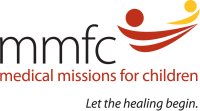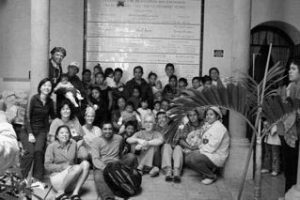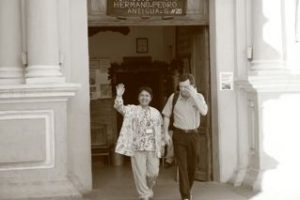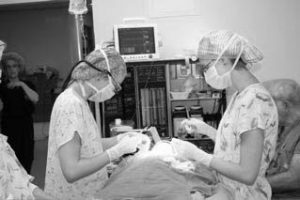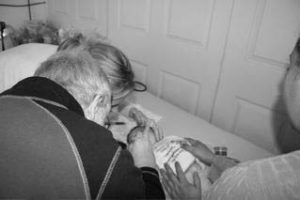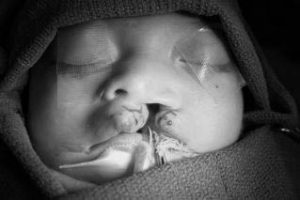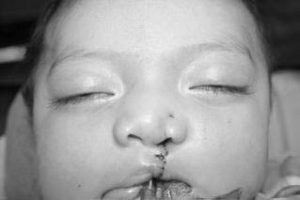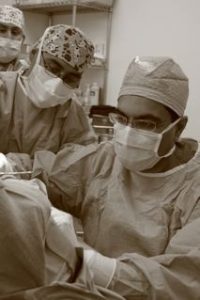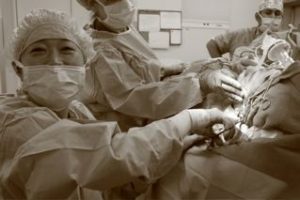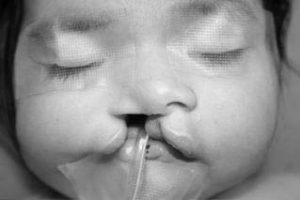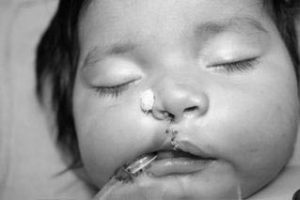Antigua, Guatemala – January 3-10, 2009
Obras Sociales del Hermano Pedro Hospital
Dr. Adele Evans is a Pediatric Otolaryngologist who resides in Winston-Salem, NC with her physician husband Jerry, two- year old daughter Cora, and dog Grady. She works at Brenner Children’s Hospital and is an assistant professor of Pediatric Otolaryngology – Head & Neck Surgery at Wake Forest University School of Medicine. Adele began volunteering with Medical Missions for Children (“MMFC”) on the Antigua, Guatemala Mission in 2005 and returns annually. She is grateful to all of her supporters and the donors who sponsor her annual mission. These are some of her journal entries.
Pre-mission
It is a month before the mission to Guatemala but I am already preparing. It is always difficult to think of leaving my family and especially my 2 year old daughter, Cora, for an entire week. It is difficult, but there is never any question that I will go. I grew up in a medical household, with a surgeon-father and a nurse-mother. My mother always taught us to take good care of our things and to pass them along when they could serve someone else. In essence we were taught to share, whether that meant our material goods, or the skills we possess, or both. Now that I am a mom, I want to teach my daughter the same simple but powerful lesson. So I teach Cora to share by putting a quarter in the Salvation Army red-bucket at Christmastime and to send the toys she doesn’t need anymore to the babies in Guatemala. And I teach her to “share” her mom with other children in need when I go to Guatemala each year to share my skills as a surgeon.
Day 1: Travel
The vast majority of our team members arrive in Antigua from Guatemala City and the airport today. Our team is comprised of anesthesiologists and nurse-anesthetists from Boston, NYC, St. Louis and San Diego; nurses from Boston and NYC; otolaryngologists from Boston, NYC, Winston-Salem and San Diego, and support staff from Boston. All but two bags arrive as scheduled; the others are scheduled to follow tomorrow when the next daily flight from the US arrives. We are all traveling with bags of supplies and equipment for the hospital and patients. My bags are filled with gloves and sutures and instruments, and beanie babies collected by colleagues and staff. Oh, and this year, I took Cora’s bear, named “Travel” with me. I plan on sending Cora photos all week of him: Travel in the airport, Travel in the hotel, Travel on the plane, Travel in the hospital!
We arrive at Porta Hotel, Antigua by 4:30pm and eat a quick dinner at MonoLoco, a local dining establishment. It is an early night to bed for everyone. We are all excited about the work ahead.
Day 2: Welcome
The Team went to the hospital first thing in the morning after a breakfast at the hotel. As usual, we received a truly generous and warm greeting from Dolores, the head RN who runs the operating rooms at Obras Sociales del Hermano Pedro Hospital. Dolores knows all too well our ability to keep working … and working …all day long and into the evening. With a smile on her face, she asked us to please stick to the scheduled operating hours as much as possible because the nurses and technical staff live “lejos de aqui,” “far from here” and need to be able to catch their buses and at a safe hour in the evening.
Dolores also informed us of a new and exciting initiative at hospital. The Obras council has decided to establish an intermediate-care unit. This intermediate-care unit would have 3 adult beds and 2 pediatric beds with some capabilities for short-term ventilation. It would be a tremendous benefit to the hospital and the surrounding community. Great news!
“Proximo! (Next!) How do I say it in K’iche’? Or Kekchi? Or is it Cakchiquel?”
Instead of proceeding with the usual tour, we offer to get started immediately. In 3.5 hours we screen over 90 patients, the vast majority of whom we are able to offer surgical treatment. We see babies from 3 months old, who still weigh less than 10 lbs, to a man 47 years old.
The most touching case today, the one that brought tears to the eyes of everyone around, was Deisy. She is an 11-year 6-month old girl no taller than a 7-year old child in the States. The anterior hard palate had a large cleft present and she had a marked nasal deformity, with her nasal septum practically lying flat across the floor of her nose. She entered the room with her hand over her mouth and stood in the center of our tiny exam area and began to cry. I asked her father and grandfather, who had accompanied her, “Is she nervous?” And they said she was very nervous. I rubbed her back as I sat her down in a chair and told her we were going to help her and everything would be okay. We sat a few minutes as the others drew the curtain around our area to give her some privacy.
Deisy eventually calmed down and removed her hand, showing us what was bothering her the most… the teeth sticking forward and impossible to be covered by her lip. We decided to give her a full redo of the lip and augment it with mucco-buccal flaps, folds from other parts of her mouth to improve her lip size. And next year we will plan to completely redo her palate repair with repair of the naso-alveolar clefts that persist and even to repair her septum. By this time next year, the reason for her fear, shame and isolation will be on its way into a distant memory. We will make sure that happens for her. It is why we do what we do, Deisy and the thousands upon thousands of children like her.
The fruits of our labor become evident … It is common for many patients to travel 8 hours to the hospital to be present on the day they know we are scheduled to arrive. What is different this year, in contrast to years past, is that parents are relaxed and smiling when they arrive. There is much less fear of the surgery and much less fear of the hospital. The parents have always been gracious at the end of the week, but there has been an underlying sense of fear and anxiety about what happens at the hospital. I attribute this change to the good work done at the hospital, to the hard work done by MMFC and to our repeated annual presence with a core of strong surgeons and medical support staff. It is truly one of the things that sets MMFC apart and is a source of particular pride for all of us: we continue to return to our host sites and more importantly, to our patients, year after year after year.
As a result, our efforts are evident to all. Our young patients, once ostracized and kept at home, are being sent to school now. Parents who speak Mayan dialects are learning Spanish and teaching it to the children to help them succeed professionally and academically. This is a new era here in old Guatemala. The families here are expressing excitement about the future. And they are starting to self-advocate.
Day 5: Mid-week self assessment
We now have three days of operating behind us and two more to go. We are averaging 6.5 cases per room per day in each of the two cleft lip and palate rooms, and we are averaging 4 cases per day in the microtia room. We have been able to accomplish some impressive primary surgeries in the younger children. Everyone is pleased!
Each day consists of heading to the hospital around 7am, rounding on the previous day’s surgical patients, and then getting changed into scrubs to start the new operative day. There is no heating or air conditioning; the hospital is a fresh-air facility and the climate here is perfect for it. Temperatures are crisp and cool during the night and warm and comfortable by day.
The nurses, who are generally graduates of a 9th grade education and 18-years old or older who have finished a clinical practice equivalent of a technical school, record the milk and formula intake of the babies. They administer the medicines with the moms. And each mom, who has stayed at the bedside, learns how to feed her child with “una heringa,” a syringe with a little rubber tip on the end.
The cleft-palate repair patients all have a rescue suture, running from their tongues forward and taped on the cheek. The safe and ready-to-go patients get their suture snipped and removed, and the patients are sent home with amoxicillin and Tylenol.
Back to Basic Needs
Yesterday, we had to make a difficult, but correct decision, to postpone surgery on an infant in need of a cleft lip repair. She was nearly 4 months old, meeting the age requirements. But she weighed in at a mere 6 pounds, falling 4 pounds short of the general criteria for a safe surgical repair. This was sad for everyone, but the safe decision to make. We had the infant evaluated at Obras by a nutritionist where she was admitted to the hospital for failure to thrive. At 4 months old and 6 pounds in weight, she is the size of a small newborn child in the States. She will receive nutritional supplementation which will hopefully increase her body weight to allow for the surgical repair later in the year when the next team arrives.
MMFC always seeks to address these issues on two levels. First, what can we do for this patient right here and now, i.e. surgery; and what can we do to eradicate the underlying causes of the prevalence of these congenital deformities in this community, i.e. malnutrition and clean water. MMFC continues to invest its resources on both fronts.
Final Day
Today is the last day. I am sad to leave this little town even though I miss my daughter and family and am excited to see them again. But by now I understand that Antigua and the people who live here will be here next year when I return. MMFC will return, and I will return.
Final Thoughts
The water is running in my bathroom back home in North Carolina. I am thinking about the dirt-floor homes in Antigua and the little babies we treated. My daughter is brushing her teeth. I am thinking about the little babies and their teeth. And Cora says, holding her toothbrush in her hand, “Can we send these to them?” And I am shaken out of my memories and brought back to the present by her sweet voice. I look at her, and say “What, Cora? What did you say?” And she looks up at me and answers, “Yes, let’s send these to the babies next time … the babies in Gua-te-ma-la, okay?”
